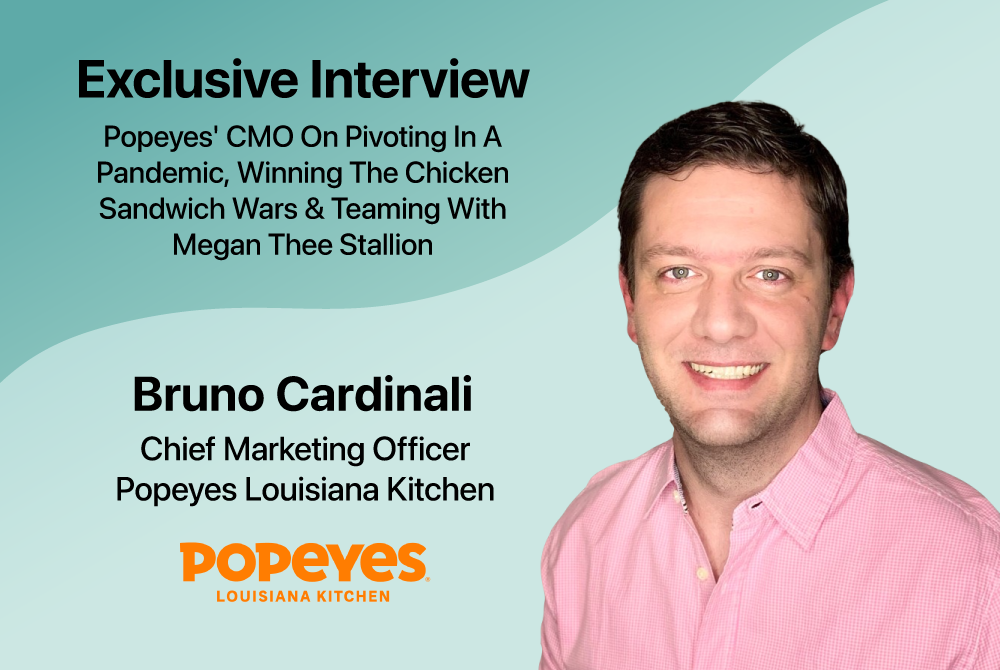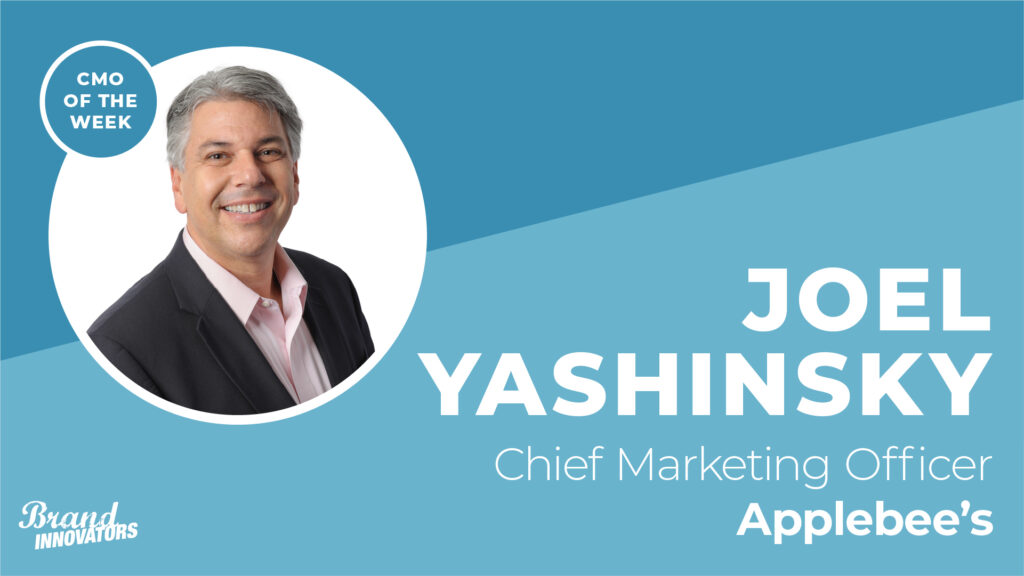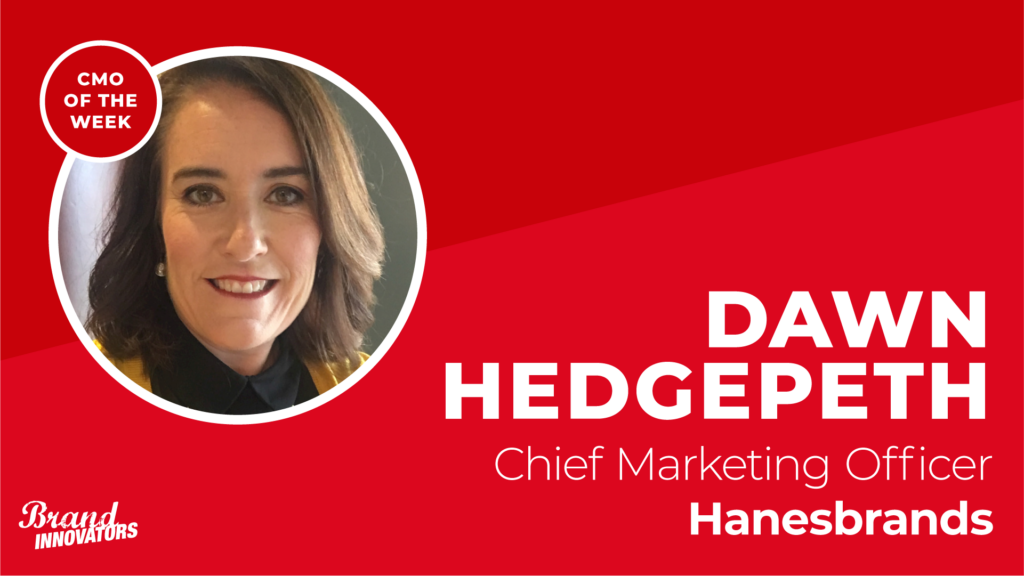It started with a chicken sandwich.
When Bruno Cardinali joined Popeyes Louisiana Kitchen as its chief marketing officer in March 2019, his first task was to help the Restaurant Brands International restaurant chain shift its perception as a bone-in, fried chicken-only destination and expand into more dining occasions.
Enter the chicken sandwich, Popeyes’ first major entry into the boneless chicken sandwich category that was only being served at a national level at the time by a small segment of quick-service restaurant (QSR) brands. The sandwich had just launched locally in Houston by the time Cardinali came onboard, which is when he first saw the potential to tap into something potentially much bigger.
“The first thing I did was go to Houston, tried the sandwich myself, and I came back [to Miami] and I said, ‘Let’s look at Twitter, and search ‘Popeyes sandwich,’” Cardinali recalls. “And man, there were just a ton of conversations about the chicken sandwich happening in Houston. Lots of people talking about the product, and celebrating it and talking about how amazing the product was and making comparisons to other sandwiches in the market. So I felt there was a hype going on and I put together a new brief for the agency that said, ‘in a word, believe the hype.’”
The approach paid off – and in a big way. A national August 2019 launch, coupled with a social media battle dubbed “The Chik-Fil-A Challenge,” led to a surge in demand and store traffic, prompting sales of 1,000 chicken sandwiches per day before sellouts in many markets. The company later attributed a sales boost of $400,000 per store directly launch. In 2020, the craze led to a “chicken sandwich war” in the QSR category, inspiring copycat menu items from McDonald’s and KFC, and even a hand-breaded chicken sandwich from Popeyes’ RBI sibling brand Burger King (dubbed the Ch’King).
Now two years out from the launch of the chicken sandwich, Popeyes is hoping to see continued sales momentum from its new market share. Parent company RBI reported a 5.5% increase in system-wide sales growth for Popeyes during its third-quarter 2021 earnings, partially offset by a 4.5% decrease in U.S. comparable sales.
Up next, Popeyes is turning to nuggets as its latest boneless menu item – with a little help from a co-branded hot sauce created in partnership with Grammy-winning rapper Megan Thee Stallion. A vibrant commercial announcing the new menu item “Hottie Sauce” (named after the musician’s fan base) debuted in November, which coincided with the announcement that Megan Thee Stallion would become a part owner of a Popeyes franchise location in her hometown of Houston next year.
Brand Innovators caught up with Cardinal from his Miami office to learn about the musical new collab, his many pivots from the past two years and key lessons learned from the chicken sandwich wars. The conversation has been edited for length and clarity.
Brand Innovators: How did the COVID-19 pandemic initially impact your business, and what are some pivots or innovations you put in place to adapt to the new market conditions?
Bruno Cardinali: I think the main pivot we did was from an innovation standpoint, it was doubling down on delivery. We had business there before the pandemic — we were setting up the foundation trying to test a bunch of frameworks. But with the pandemic, we had to innovate and execute on a bunch of different levels which was really helpful for us.
The launch of loyalty as well helped just start to drive a better line of communication with our guests, which is something we started to roll out in 2020, but we finished this year. We took the time to do the programming in the best possible way by checking with guests for their preferences and structuring the program with a points or cash-back based program.Those two things were the biggest innovations we deployed in this period.
Given all the different waves of lockdown and post-lockdown from the past two years, how has the tone of your messaging evolved during those phases?
With COVID, the first wave was in New York, and the second one was in New Orleans which impacted us since it’s our hometown. We felt it was a great place to take a stand and try to help the community. At that time we launched a campaign called “NOLA Strong,” the voiceover was done by Wendell Pierce to help the community and say “How can we help?” We deployed some menu items that were donating a portion of those proceeds to local charities, and we donated more than 1 million meals in New Orleans. So the tone there was being part of the community.
And then understanding what’s happening on social media, I guess pre-COVID the tone was a little bit more daring, more fun, trying to make jokes and play in that arena. I think COVID restrained a lot of that and became much more a tone of “we’re in this together, supporting each other.” We didn’t want to go into that arena of trying to make fun. People were not really in that mindset.
And then if you fast forward to the end of the year and this year, consumers then started to ask for fun again. We’ve been on this journey for so long, how can we bring some lightness into the world?
You played a leading role in the so-called “chicken sandwich wars” shortly after joining Popeyes in 2019. How has that competition evolved in the years since, especially as many more players have entered the space? How have you evolved your menu to stay relevant?
While I was working on brand voice and brand personality when I first joined the company, the main thing was rolling out the chicken sandwiches to the whole country. The team had already briefed the agency to come up with a national campaign, and the brief was something very functional, very product-driven. I told them it should be about one word, “believe the hype.”
So the brief became first, try the product and go on social media and see how much people are talking about it and then show everyone in the country that the hype is real. At the same time, in that process as I was rebriefing the agency on chicken sandwiches I also realized that working with an agency at that time GSD&M on social media listening and strategy, I realized people absolutely love the brand they just talk about it and everything else. We pivoted a little bit of our focus, before it was very heavy on social media, for every single limited-time offer we launched we would develop a whole new campaign.
So we pivoted our approach to focus more on PR and social media, and that was I think the key for us to get the sandwich to the place that it is currently. Doubling down on that, it was our chance to be more active on social media, and react fast in a way that’s really true to Popeyes. The tone of voice and personality of the brand really came alive into that conversation and from there onwards it’s been a great ride.
We sold out of the sandwich for the first time, which was very unfortunate but in the end helped drive more anticipation for the second launch. It was a tough six weeks for me to be honest with you. We launched for I think 10 days max, I remember it was a Saturday and we were going through inventory, and we just had to make the call we’re gonna have to stop these things. Half of the room was not in favor of stopping, let’s just continue selling, even if you just sell one day a week it’s better to sell. And the challenge it put me and I put to myself was how do we regain all this momentum in the relaunch? The risk is no one’s gonna remember or be into it. So that’s what we tried to do, is keep the brand alive and the conversation in those six weeks.
How does Popeyes’ new partnership with Megan Thee Stallion help in further advancing your competitive position the boneless chicken category, and how does it help expand your potential audience targets?
I think the whole genre went through us seeing the market evolving, to seek a partnership. There was also a business need which was we were launching nuggets in July of this year, so we wanted to do a campaign called “Come in Piece.” The nuggets were eight pieces, ending the chicken sandwich wars.
The second punch was supposed to be a sauce activation, so start with nuggets awareness and trial and then come back with sauce to help drive the business. So that’s when we said “maybe we could partner with someone to do the sauce?” And that’s when we started to evolve the idea. Megan Thee Stallion has always been on our radar when we launched the chicken sandwich in August 2019, she was one of the first celebrities who got her sandwich and posted on social media extensively. We were really grateful for her doing that because it helps a lot to spread the news and get the hype around the sandwich.
So we knew she was a super fan of the brand, we knew that affinity was in place. And we started to research more about her style, her personality, what things she likes, how she does music, and all the storytelling that’s intrinsic to how she writes her music. And we felt it was a perfect match. She’s from Houston, we’re from New Orleans, and we approached [her management company] Roc Nation with a proposal to work together, and it’s been a great partnership. If you look at the final product, the sauce, the scripts, the campaign idea, choosing the director, the animation group, the storytelling — it’s something that for Megan Thee Stallion’s fans you see a lot of cues to her because we worked on everything in collaboration. We have her two personas Tina Snow and Megan herself, a lot of cues into the campaign which I thought was a great way to bring the story to life and truly collaborate beyond just a name on packaging and that’s it.
And then we also put the icing on the cake with the franchising deal, which was unexpected. It came up late in the work, it wasn’t part of the initial proposal, but as we started to work together it felt natural. So it was a great feat for all of us.
How have you adapted your media mix during the pandemic era – what channels or platforms are you investing in more heavily than you did pre-pandemic, and why?
We’ve adjusted quite a lot of our media mix. The three main changes I can call out here, the first one is a move from linear to connected TV, so that move happened right from the get-go in 2020. When we saw a lot of people staying home and watching streaming services.
The second one was digital as a whole, pivoting from TV to digital media. And the third was within digital, the growth of our ecomm business and loyalty and delivery is doubling down on performance media. Those three changes really accelerated in 2020.
How has the worker shortage impacted Popeyes’ business this year, and what are some ways you’re addressing that in your marketing by showcasing the workplace & employee benefits or joining the Popeyes team?
The Popeyes restaurants, like most, are franchised, and everything in its employment matters including hires is all done through the franchisees. We do own 41 stores in the U.S. — 25 in New Orleans and 16 in Memphis, but the other 2,600 are franchise owned. So we do see the labor and hiring issues affecting most industries, especially food and hospitality. What we normally do here is work with franchisees closely to build best practices, with the ones doing better than others, and create a culture where people feel inspired to join the team and be a part of it. What we do from our side is create training programs and give all the support on the franchisees side to onboard people.
What we’ve seen in the QSR industry is the first three, four days are absolutely crucial for franchises to retain people. If they don’t have a good experience in the first two to three days, they don’t come back. The turnover is much quicker for us than other industries, so those first four days are super important for franchises to retain employees and to motivate them and inspire them into the brand.




